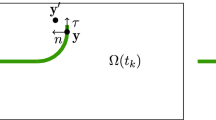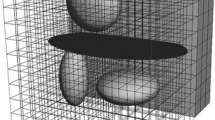Abstract
The paper presents the utilization of the adaptive Delaunay triangulation in the finite element modeling of two dimensional crack propagation problems, including detailed description of the proposed procedure which consists of the Delaunay triangulation algorithm and an adaptive remeshing technique. The adaptive remeshing technique generates small elements around crack tips and large elements in the other regions. The resulting stress intensity factors and simulated crack propagation behavior are used to evaluate the effectiveness of the procedure. Three sample problems of a center cracked plate, a single edge cracked plate and a compact tension specimen, are simulated and their results assessed.
Similar content being viewed by others
References
Bowyer A. Computing Dirichlet tessellations.Comp J, 1981, 24: 162–166
Watson DF. Computing then-dimensional Delaunay tessellation with application to voronoi polytopes.Comp J, 1981, 24: 167–172
Weatherill NP, Hassan O. Efficient three-dimension Delaunay triangulation with automatic point creation and imposed boundary constraints.Int J Numer Methods Eng, 1994, 37: 2005–2039
Karamete BK, Tokdemir T, Ger M. Unstructured grid generation and a simple triangulation algorithm for arbitrary 2-D geometries using object oriented programming.Int J Numer Methods Eng, 1997, 40: 251–268
Barsoum RS. On the use of isoparametric finite elements in linear fracture mechanics.Int J Numer Methods Eng, 1976, 10: 25–37
Barsoum RS. Triangular quarter-point elements as elastic and perfectly-plastic crack tip elements.Int J Numer Methods Eng, 1977, 11: 85–98
Chan SK, Tuba IS, Wilson WK. On the finite element method in linear fracture mechanics.Eng Fract Mech, 1970 2(1):1–17
Guinea GV, Planas J, Elices M.K 1 Evaluation by the displacement extrapolation technique.Eng Fract Mech, 2000, 66: 243–255
Erdogan F, Sih GC. On the crack extension in plates under plane loading and transverse shear.J Basic Eng, 1963, 85: 519–527
Lee KY, Lee JD, Liebowitz H. Finite element analysis of the slow crack growth process in mixed mode fracture.Eng Fract Mech, 1974, 56: 551–577
Zienkiewicz OC. Taylor RL. Finite Element Method. Fifth edition. Woburn: Butterworth-Heinemann, 2000
Phongthanapanich S. Dechaumphai P. Underwater explosion simulation by transient adaptive Delaunay triangulation meshing technique. Technical Report submitted to the Royal Thai Navy, TR-3894. Bangkok, 2002
Lawson CL. Software for C1 Surface Interpolation. In: Rice JR ed. Mathematical Software III. New York: Academic Press, 1977
Sloan SW. A fast algorithm for generating constrained Delaunay triangulations.Comp Struct, 1993, 47: 441–450
Frey WH. Selective Refinement: A new strategy for automatic node placement in graded triangular meshes.Int J Numer Methods Eng, 1987, 24: 2183–2200
Borouchaki H, George PL. Aspects of 2-D Delaunay mesh generation.Int J Numer Methods Eng, 1997, 40: 1957–1975
Peraire J, Vahdati M, Morgan K, Zienkiewicz OC. Adaptive remeshing for compressible flow computations.J Comput Phys, 1987, 72: 449–466
Dechaumphai P. Improvement of plane stress solutions using adaptive finite elements.J Chin Inst Eng, 1996, 19: 375–380
Isida M. Effect of width and length on stress intensity factors of internally cracked plates under various boundary conditions.Int J Fract, 1971, 7: 301–316
Murakami Y, ed Stress Intensity Factors Handbook, Oxford: Pergamon Press, 1987
ASTM 1996. Annual Book of ASTM Standards. Philadelphia, Philadelphia: American Society for Testing and Materials, 1996
Rao BN, Rahman S. An efficient meshless method for fracture analysis of cracks.Comput Mech, 2000, 26: 398–408
Author information
Authors and Affiliations
Additional information
The project supported by the Thailand Research Fund (TFR)
Rights and permissions
About this article
Cite this article
Dechaumphai, P., Phongthanapanich, S. & Sricharoenchai, T. Combined Delaunay triangulation and adaptive finite element method for crack growth analysis. Acta Mech Sinica 19, 162–171 (2003). https://doi.org/10.1007/BF02487678
Received:
Revised:
Issue Date:
DOI: https://doi.org/10.1007/BF02487678




